YOLO V4出来也几天了,论文大致看了下,然后看到大量的优秀者实现了各个版本的YOLOV4了。
Yolo v4 论文: https://arxiv.org/abs/2004.10934
AB大神Darknet版本的源码实现: https://github.com/AlexeyAB/darknet
本文针对Pytorch版本实现的YOLOV4进行分析,感谢Tianxiaomo 分享的工程:Pytorch-YoloV4
作者分享的权重文件,下载地址:
- baidu(https://pan.baidu.com/s/1dAGEW8cm-dqK14TbhhVetA Extraction code:dm5b)
- google(https://drive.google.com/open?id=1cewMfusmPjYWbrnuJRuKhPMwRe_b9PaT)
该权重文件yolov4.weights 是在coco数据集上训练的,目标类有80种,当前工程支持推理,不包括训练~
我的测试环境是anaconda配置的环境,pytorch1.0.1, torchvision 0.2.1;
工程目录如下:

终端运行指令:
# 指令需要传入cfg文件路径,权重文件路径,图像路径
>>python demo.py cfg/yolov4.cfg yolov4.weights data/dog.jpg运行结果会生成一张检测后的图:predictions.jpg
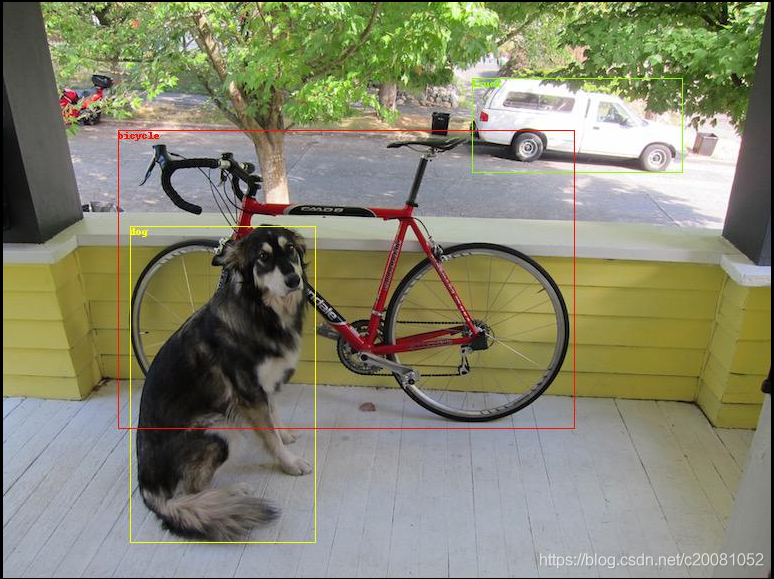
接下来对源码做分析:
其中demo.py中,主要调用了函数detect(),其代码如下:
def detect(cfgfile, weightfile, imgfile):
m = Darknet(cfgfile) #穿件Darknet模型对象m
m.print_network() # 打印网络结构
m.load_weights(weightfile) #加载权重值
print('Loading weights from %s... Done!' % (weightfile))
num_classes = 80
if num_classes == 20:
namesfile = 'data/voc.names'
elif num_classes == 80:
namesfile = 'data/coco.names'
else:
namesfile = 'data/names'
use_cuda = 0 # 是否使用cuda,工程使用的是cpu执行
if use_cuda:
m.cuda() # 如果使用cuda则将模型对象拷贝至显存,默认GUP ID为0;
img = Image.open(imgfile).convert('RGB') # PIL打开图像
sized = img.resize((m.width, m.height))
for i in range(2):
start = time.time()
boxes = do_detect(m, sized, 0.5, 0.4, use_cuda) # 做检测,返回的boxes是昨晚nms后的检测框;
finish = time.time()
if i == 1:
print('%s: Predicted in %f seconds.' % (imgfile, (finish - start)))
class_names = load_class_names(namesfile) # 加载类别名
plot_boxes(img, boxes, 'predictions.jpg', class_names)# 画框,并输出检测结果图像文件;在创建Darknet()对象过程中,会根据传入的cfg文件做初始化工作,主要是cfg文件的解析,提取cfg中的每个block;网络结构的构建;(如下图)

现在先说下根据cfg文件是如何解析网络结果吧,主要调用了tool/cfg.py的parse_cfg()函数,它会返回blocks,网络结果是长这个样子的(使用Netron网络查看工具 打开cfg文件,完整版请自行尝试):

创建网络模型是调用了darknet2pytorch.py中的create_network()函数,它会根据解析cfg得到的blocks构建网络,先创建个ModuleList模型列表,为每个block创建个Sequential(),将每个block中的卷积操作,BN操作,激活操作都放到这个Sequential()中;可以理解为每个block对应一个Sequential();
构建好的的ModuleList模型列表大致结构如下:
Darknet(
(models): ModuleList(
(0): Sequential(
(conv1): Conv2d(3, 32, kernel_size=(3, 3), stride=(1, 1), padding=(1, 1), bias=False)
(bn1): BatchNorm2d(32, eps=1e-05, momentum=0.1, affine=True, track_running_stats=True)
(mish1): Mish()
)
(1): Sequential(
(conv2): Conv2d(32, 64, kernel_size=(3, 3), stride=(2, 2), padding=(1, 1), bias=False)
(bn2): BatchNorm2d(64, eps=1e-05, momentum=0.1, affine=True, track_running_stats=True)
(mish2): Mish()
)
(2): Sequential(
(conv3): Conv2d(64, 64, kernel_size=(1, 1), stride=(1, 1), bias=False)
(bn3): BatchNorm2d(64, eps=1e-05, momentum=0.1, affine=True, track_running_stats=True)
(mish3): Mish()
)
(3): EmptyModule()
(4): Sequential(
(conv4): Conv2d(64, 64, kernel_size=(1, 1), stride=(1, 1), bias=False)
(bn4): BatchNorm2d(64, eps=1e-05, momentum=0.1, affine=True, track_running_stats=True)
(mish4): Mish()
)
(5): Sequential(
(conv5): Conv2d(64, 32, kernel_size=(1, 1), stride=(1, 1), bias=False)
(bn5): BatchNorm2d(32, eps=1e-05, momentum=0.1, affine=True, track_running_stats=True)
(mish5): Mish()
)
(6): Sequential(
(conv6): Conv2d(32, 64, kernel_size=(3, 3), stride=(1, 1), padding=(1, 1), bias=False)
(bn6): BatchNorm2d(64, eps=1e-05, momentum=0.1, affine=True, track_running_stats=True)
(mish6): Mish()
)
(7): EmptyModule()
(8): Sequential(
(conv7): Conv2d(64, 64, kernel_size=(1, 1), stride=(1, 1), bias=False)
(bn7): BatchNorm2d(64, eps=1e-05, momentum=0.1, affine=True, track_running_stats=True)
(mish7): Mish()
)
(9): EmptyModule()
(10): Sequential(
(conv8): Conv2d(128, 64, kernel_size=(1, 1), stride=(1, 1), bias=False)
(bn8): BatchNorm2d(64, eps=1e-05, momentum=0.1, affine=True, track_running_stats=True)
(mish8): Mish()
)
(11): Sequential(
(conv9): Conv2d(64, 128, kernel_size=(3, 3), stride=(2, 2), padding=(1, 1), bias=False)
(bn9): BatchNorm2d(128, eps=1e-05, momentum=0.1, affine=True, track_running_stats=True)
(mish9): Mish()
)
(12): Sequential(
(conv10): Conv2d(128, 64, kernel_size=(1, 1), stride=(1, 1), bias=False)
(bn10): BatchNorm2d(64, eps=1e-05, momentum=0.1, affine=True, track_running_stats=True)
(mish10): Mish()
)
(13): EmptyModule()
(14): Sequential(
(conv11): Conv2d(128, 64, kernel_size=(1, 1), stride=(1, 1), bias=False)
(bn11): BatchNorm2d(64, eps=1e-05, momentum=0.1, affine=True, track_running_stats=True)
(mish11): Mish()
)
(15): Sequential(
(conv12): Conv2d(64, 64, kernel_size=(1, 1), stride=(1, 1), bias=False)
(bn12): BatchNorm2d(64, eps=1e-05, momentum=0.1, affine=True, track_running_stats=True)
(mish12): Mish()
)
(16): Sequential(
(conv13): Conv2d(64, 64, kernel_size=(3, 3), stride=(1, 1), padding=(1, 1), bias=False)
(bn13): BatchNorm2d(64, eps=1e-05, momentum=0.1, affine=True, track_running_stats=True)
(mish13): Mish()
)
(17): EmptyModule()
(18): Sequential(
(conv14): Conv2d(64, 64, kernel_size=(1, 1), stride=(1, 1), bias=False)
(bn14): BatchNorm2d(64, eps=1e-05, momentum=0.1, affine=True, track_running_stats=True)
(mish14): Mish()
)
(19): Sequential(
(conv15): Conv2d(64, 64, kernel_size=(3, 3), stride=(1, 1), padding=(1, 1), bias=False)
(bn15): BatchNorm2d(64, eps=1e-05, momentum=0.1, affine=True, track_running_stats=True)
(mish15): Mish()
)
(20): EmptyModule()
(21): Sequential(
(conv16): Conv2d(64, 64, kernel_size=(1, 1), stride=(1, 1), bias=False)
(bn16): BatchNorm2d(64, eps=1e-05, momentum=0.1, affine=True, track_running_stats=True)
(mish16): Mish()
)
(22): EmptyModule()
(23): Sequential(
(conv17): Conv2d(128, 128, kernel_size=(1, 1), stride=(1, 1), bias=False)
(bn17): BatchNorm2d(128, eps=1e-05, momentum=0.1, affine=True, track_running_stats=True)
(mish17): Mish()
)
(24): Sequential(
(conv18): Conv2d(128, 256, kernel_size=(3, 3), stride=(2, 2), padding=(1, 1), bias=False)
(bn18): BatchNorm2d(256, eps=1e-05, momentum=0.1, affine=True, track_running_stats=True)
(mish18): Mish()
)
(25): Sequential(
(conv19): Conv2d(256, 128, kernel_size=(1, 1), stride=(1, 1), bias=False)
(bn19): BatchNorm2d(128, eps=1e-05, momentum=0.1, affine=True, track_running_stats=True)
(mish19): Mish()
)
(26): EmptyModule()
(27): Sequential(
(conv20): Conv2d(256, 128, kernel_size=(1, 1), stride=(1, 1), bias=False)
(bn20): BatchNorm2d(128, eps=1e-05, momentum=0.1, affine=True, track_running_stats=True)
(mish20): Mish()
)
(28): Sequential(
(conv21): Conv2d(128, 128, kernel_size=(1, 1), stride=(1, 1), bias=False)
(bn21): BatchNorm2d(128, eps=1e-05, momentum=0.1, affine=True, track_running_stats=True)
(mish21): Mish()
)
(29): Sequential(
(conv22): Conv2d(128, 128, kernel_size=(3, 3), stride=(1, 1), padding=(1, 1), bias=False)
(bn22): BatchNorm2d(128, eps=1e-05, momentum=0.1, affine=True, track_running_stats=True)
(mish22): Mish()
)
(30): EmptyModule()
(31): Sequential(
(conv23): Conv2d(128, 128, kernel_size=(1, 1), stride=(1, 1), bias=False)
(bn23): BatchNorm2d(128, eps=1e-05, momentum=0.1, affine=True, track_running_stats=True)
(mish23): Mish()
)
(32): Sequential(
(conv24): Conv2d(128, 128, kernel_size=(3, 3), stride=(1, 1), padding=(1, 1), bias=False)
(bn24): BatchNorm2d(128, eps=1e-05, momentum=0.1, affine=True, track_running_stats=True)
(mish24): Mish()
)
(33): EmptyModule()
(34): Sequential(
(conv25): Conv2d(128, 128, kernel_size=(1, 1), stride=(1, 1), bias=False)
(bn25): BatchNorm2d(128, eps=1e-05, momentum=0.1, affine=True, track_running_stats=True)
(mish25): Mish()
)
(35): Sequential(
(conv26): Conv2d(128, 128, kernel_size=(3, 3), stride=(1, 1), padding=(1, 1), bias=False)
(bn26): BatchNorm2d(128, eps=1e-05, momentum=0.1, affine=True, track_running_stats=True)
(mish26): Mish()
)
(36): EmptyModule()
(37): Sequential(
(conv27): Conv2d(128, 128, kernel_size=(1, 1), stride=(1, 1), bias=False)
(bn27): BatchNorm2d(128, eps=1e-05, momentum=0.1, affine=True, track_running_stats=True)
(mish27): Mish()
)
(38): Sequential(
(conv28): Conv2d(128, 128, kernel_size=(3, 3), stride=(1, 1), padding=(1, 1), bias=False)
(bn28): BatchNorm2d(128, eps=1e-05, momentum=0.1, affine=True, track_running_stats=True)
(mish28): Mish()
)
(39): EmptyModule()
(40): Sequential(
(conv29): Conv2d(128, 128, kernel_size=(1, 1), stride=(1, 1), bias=False)
(bn29): BatchNorm2d(128, eps=1e-05, momentum=0.1, affine=True, track_running_stats=True)
(mish29): Mish()
)
(41): Sequential(
(conv30): Conv2d(128, 128, kernel_size=(3, 3), stride=(1, 1), padding=(1, 1), bias=False)
(bn30): BatchNorm2d(128, eps=1e-05, momentum=0.1, affine=True, track_running_stats=True)
(mish30): Mish()
)
(42): EmptyModule()
(43): Sequential(
(conv31): Conv2d(128, 128, kernel_size=(1, 1), stride=(1, 1), bias=False)
(bn31): BatchNorm2d(128, eps=1e-05, momentum=0.1, affine=True, track_running_stats=True)
(mish31): Mish()
)
(44): Sequential(
(conv32): Conv2d(128, 128, kernel_size=(3, 3), stride=(1, 1), padding=(1, 1), bias=False)
(bn32): BatchNorm2d(128, eps=1e-05, momentum=0.1, affine=True, track_running_stats=True)
(mish32): Mish()
)
(45): EmptyModule()
(46): Sequential(
(conv33): Conv2d(128, 128, kernel_size=(1, 1), stride=(1, 1), bias=False)
(bn33): BatchNorm2d(128, eps=1e-05, momentum=0.1, affine=True, track_running_stats=True)
(mish33): Mish()
)
(47): Sequential(
(conv34): Conv2d(128, 128, kernel_size=(3, 3), stride=(1, 1), padding=(1, 1), bias=False)
(bn34): BatchNorm2d(128, eps=1e-05, momentum=0.1, affine=True, track_running_stats=True)
(mish34): Mish()
)
(48): EmptyModule()
(49): Sequential(
(conv35): Conv2d(128, 128, kernel_size=(1, 1), stride=(1, 1), bias=False)
(bn35): BatchNorm2d(128, eps=1e-05, momentum=0.1, affine=True, track_running_stats=True)
(mish35): Mish()
)
(50): Sequential(
(conv36): Conv2d(128, 128, kernel_size=(3, 3), stride=(1, 1), padding=(1, 1), bias=False)
(bn36): BatchNorm2d(128, eps=1e-05, momentum=0.1, affine=True, track_running_stats=True)
(mish36): Mish()
)
(51): EmptyModule()
(52): Sequential(
(conv37): Conv2d(128, 128, kernel_size=(1, 1), stride=(1, 1), bias=False)
(bn37): BatchNorm2d(128, eps=1e-05, momentum=0.1, affine=True, track_running_stats=True)
(mish37): Mish()
)
(53): EmptyModule()
(54): Sequential(
(conv38): Conv2d(256, 256, kernel_size=(1, 1), stride=(1, 1), bias=False)
(bn38): BatchNorm2d(256, eps=1e-05, momentum=0.1, affine=True, track_running_stats=True)
(mish38): Mish()
)
(55): Sequential(
(conv39): Conv2d(256, 512, kernel_size=(3, 3), stride=(2, 2), padding=(1, 1), bias=False)
(bn39): BatchNorm2d(512, eps=1e-05, momentum=0.1, affine=True, track_running_stats=True)
(mish39): Mish()
)
(56): Sequential(
(conv40): Conv2d(512, 256, kernel_size=(1, 1), stride=(1, 1), bias=False)
(bn40): BatchNorm2d(256, eps=1e-05, momentum=0.1, affine=True, track_running_stats=True)
(mish40): Mish()
)
(57): EmptyModule()
(58): Sequential(
(conv41): Conv2d(512, 256, kernel_size=(1, 1), stride=(1, 1), bias=False)
(bn41): BatchNorm2d(256, eps=1e-05, momentum=0.1, affine=True, track_running_stats=True)
(mish41): Mish()
)
(59): Sequential(
(conv42): Conv2d(256, 256, kernel_size=(1, 1), stride=(1, 1), bias=False)
(bn42): BatchNorm2d(256, eps=1e-05, momentum=0.1, affine=True, track_running_stats=True)
(mish42): Mish()
)
(60): Sequential(
(conv43): Conv2d(256, 256, kernel_size=(3, 3), stride=(1, 1), padding=(1, 1), bias=False)
(bn43): BatchNorm2d(256, eps=1e-05, momentum=0.1, affine=True, track_running_stats=True)
(mish43): Mish()
)
(61): EmptyModule()
(62): Sequential(
(conv44): Conv2d(256, 256, kernel_size=(1, 1), stride=(1, 1), bias=False)
(bn44): BatchNorm2d(256, eps=1e-05, momentum=0.1, affine=True, track_running_stats=True)
(mish44): Mish()
)
(63): Sequential(
(conv45): Conv2d(256, 256, kernel_size=(3, 3), stride=(1, 1), padding=(1, 1), bias=False)
(bn45): BatchNorm2d(256, eps=1e-05, momentum=0.1, affine=True, track_running_stats=True)
(mish45): Mish()
)
(64): EmptyModule()
(65): Sequential(
(conv46): Conv2d(256, 256, kernel_size=(1, 1), stride=(1, 1), bias=False)
(bn46): BatchNorm2d(256, eps=1e-05, momentum=0.1, affine=True, track_running_stats=True)
(mish46): Mish()
)
(66): Sequential(
(conv47): Conv2d(256, 256, kernel_size=(3, 3), stride=(1, 1), padding=(1, 1), bias=False)
(bn47): BatchNorm2d(256, eps=1e-05, momentum=0.1, affine=True, track_running_stats=True)
(mish47): Mish()
)
(67): EmptyModule()
(68): Sequential(
(conv48): Conv2d(256, 256, kernel_size=(1, 1), stride=(1, 1), bias=False)
(bn48): BatchNorm2d(256, eps=1e-05, momentum=0.1, affine=True, track_running_stats=True)
(mish48): Mish()
)
(69): Sequential(
(conv49): Conv2d(256, 256, kernel_size=(3, 3), stride=(1, 1), padding=(1, 1), bias=False)
(bn49): BatchNorm2d(256, eps=1e-05, momentum=0.1, affine=True, track_running_stats=True)
(mish49): Mish()
)
(70): EmptyModule()
(71): Sequential(
(conv50): Conv2d(256, 256, kernel_size=(1, 1), stride=(1, 1), bias=False)
(bn50): BatchNorm2d(256, eps=1e-05, momentum=0.1, affine=True, track_running_stats=True)
(mish50): Mish()
)
(72): Sequential(
(conv51): Conv2d(256, 256, kernel_size=(3, 3), stride=(1, 1), padding=(1, 1), bias=False)
(bn51): BatchNorm2d(256, eps=1e-05, momentum=0.1, affine=True, track_running_stats=True)
(mish51): Mish()
)
(73): EmptyModule()
(74): Sequential(
(conv52): Conv2d(256, 256, kernel_size=(1, 1), stride=(1, 1), bias=False)
(bn52): BatchNorm2d(256, eps=1e-05, momentum=0.1, affine=True, track_running_stats=True)
(mish52): Mish()
)
(75): Sequential(
(conv53): Conv2d(256, 256, kernel_size=(3, 3), stride=(1, 1), padding=(1, 1), bias=False)
(bn53): BatchNorm2d(256, eps=1e-05, momentum=0.1, affine=True, track_running_stats=True)
(mish53): Mish()
)
(76): EmptyModule()
(77): Sequential(
(conv54): Conv2d(256, 256, kernel_size=(1, 1), stride=(1, 1), bias=False)
(bn54): BatchNorm2d(256, eps=1e-05, momentum=0.1, affine=True, track_running_stats=True)
(mish54): Mish()
)
(78): Sequential(
(conv55): Conv2d(256, 256, kernel_size=(3, 3), stride=(1, 1), padding=(1, 1), bias=False)
(bn55): BatchNorm2d(256, eps=1e-05, momentum=0.1, affine=True, track_running_stats=True)
(mish55): Mish()
)
(79): EmptyModule()
(80): Sequential(
(conv56): Conv2d(256, 256, kernel_size=(1, 1), stride=(1, 1), bias=False)
(bn56): BatchNorm2d(256, eps=1e-05, momentum=0.1, affine=True, track_running_stats=True)
(mish56): Mish()
)
(81): Sequential(
(conv57): Conv2d(256, 256, kernel_size=(3, 3), stride=(1, 1), padding=(1, 1), bias=False)
(bn57): BatchNorm2d(256, eps=1e-05, momentum=0.1, affine=True, track_running_stats=True)
(mish57): Mish()
)
(82): EmptyModule()
(83): Sequential(
(conv58): Conv2d(256, 256, kernel_size=(1, 1), stride=(1, 1), bias=False)
(bn58): BatchNorm2d(256, eps=1e-05, momentum=0.1, affine=True, track_running_stats=True)
(mish58): Mish()
)
(84): EmptyModule()
(85): Sequential(
(conv59): Conv2d(512, 512, kernel_size=(1, 1), stride=(1, 1), bias=False)
(bn59): BatchNorm2d(512, eps=1e-05, momentum=0.1, affine=True, track_running_stats=True)
(mish59): Mish()
)
(86): Sequential(
(conv60): Conv2d(512, 1024, kernel_size=(3, 3), stride=(2, 2), padding=(1, 1), bias=False)
(bn60): BatchNorm2d(1024, eps=1e-05, momentum=0.1, affine=True, track_running_stats=True)
(mish60): Mish()
)
(87): Sequential(
(conv61): Conv2d(1024, 512, kernel_size=(1, 1), stride=(1, 1), bias=False)
(bn61): BatchNorm2d(512, eps=1e-05, momentum=0.1, affine=True, track_running_stats=True)
(mish61): Mish()
)
(88): EmptyModule()
(89): Sequential(
(conv62): Conv2d(1024, 512, kernel_size=(1, 1), stride=(1, 1), bias=False)
(bn62): BatchNorm2d(512, eps=1e-05, momentum=0.1, affine=True, track_running_stats=True)
(mish62): Mish()
)
(90): Sequential(
(conv63): Conv2d(512, 512, kernel_size=(1, 1), stride=(1, 1), bias=False)
(bn63): BatchNorm2d(512, eps=1e-05, momentum=0.1, affine=True, track_running_stats=True)
(mish63): Mish()
)
(91): Sequential(
(conv64): Conv2d(512, 512, kernel_size=(3, 3), stride=(1, 1), padding=(1, 1), bias=False)
(bn64): BatchNorm2d(512, eps=1e-05, momentum=0.1, affine=True, track_running_stats=True)
(mish64): Mish()
)
(92): EmptyModule()
(93): Sequential(
(conv65): Conv2d(512, 512, kernel_size=(1, 1), stride=(1, 1), bias=False)
(bn65): BatchNorm2d(512, eps=1e-05, momentum=0.1, affine=True, track_running_stats=True)
(mish65): Mish()
)
(94): Sequential(
(conv66): Conv2d(512, 512, kernel_size=(3, 3), stride=(1, 1), padding=(1, 1), bias=False)
(bn66): BatchNorm2d(512, eps=1e-05, momentum=0.1, affine=True, track_running_stats=True)
(mish66): Mish()
)
(95): EmptyModule()
(96): Sequential(
(conv67): Conv2d(512, 512, kernel_size=(1, 1), stride=(1, 1), bias=False)
(bn67): BatchNorm2d(512, eps=1e-05, momentum=0.1, affine=True, track_running_stats=True)
(mish67): Mish()
)
(97): Sequential(
(conv68): Conv2d(512, 512, kernel_size=(3, 3), stride=(1, 1), padding=(1, 1), bias=False)
(bn68): BatchNorm2d(512, eps=1e-05, momentum=0.1, affine=True, track_running_stats=True)
(mish68): Mish()
)
(98): EmptyModule()
(99): Sequential(
(conv69): Conv2d(512, 512, kernel_size=(1, 1), stride=(1, 1), bias=False)
(bn69): BatchNorm2d(512, eps=1e-05, momentum=0.1, affine=True, track_running_stats=True)
(mish69): Mish()
)
(100): Sequential(
(conv70): Conv2d(512, 512, kernel_size=(3, 3), stride=(1, 1), padding=(1, 1), bias=False)
(bn70): BatchNorm2d(512, eps=1e-05, momentum=0.1, affine=True, track_running_stats=True)
(mish70): Mish()
)
(101): EmptyModule()
(102): Sequential(
(conv71): Conv2d(512, 512, kernel_size=(1, 1), stride=(1, 1), bias=False)
(bn71): BatchNorm2d(512, eps=1e-05, momentum=0.1, affine=True, track_running_stats=True)
(mish71): Mish()
)
(103): EmptyModule()
(104): Sequential(
(conv72): Conv2d(1024, 1024, kernel_size=(1, 1), stride=(1, 1), bias=False)
(bn72): BatchNorm2d(1024, eps=1e-05, momentum=0.1, affine=True, track_running_stats=True)
(mish72): Mish()
)
(105): Sequential(
(conv73): Conv2d(1024, 512, kernel_size=(1, 1), stride=(1, 1), bias=False)
(bn73): BatchNorm2d(512, eps=1e-05, momentum=0.1, affine=True, track_running_stats=True)
(leaky73): LeakyReLU(negative_slope=0.1, inplace)
)
(106): Sequential(
(conv74): Conv2d(512, 1024, kernel_size=(3, 3), stride=(1, 1), padding=(1, 1), bias=False)
(bn74): BatchNorm2d(1024, eps=1e-05, momentum=0.1, affine=True, track_running_stats=True)
(leaky74): LeakyReLU(negative_slope=0.1, inplace)
)
(107): Sequential(
(conv75): Conv2d(1024, 512, kernel_size=(1, 1), stride=(1, 1), bias=False)
(bn75): BatchNorm2d(512, eps=1e-05, momentum=0.1, affine=True, track_running_stats=True)
(leaky75): LeakyReLU(negative_slope=0.1, inplace)
)
(108): MaxPoolStride1()
(109): EmptyModule()
(110): MaxPoolStride1()
(111): EmptyModule()
(112): MaxPoolStride1()
(113): EmptyModule()
(114): Sequential(
(conv76): Conv2d(2048, 512, kernel_size=(1, 1), stride=(1, 1), bias=False)
(bn76): BatchNorm2d(512, eps=1e-05, momentum=0.1, affine=True, track_running_stats=True)
(leaky76): LeakyReLU(negative_slope=0.1, inplace)
)
(115): Sequential(
(conv77): Conv2d(512, 1024, kernel_size=(3, 3), stride=(1, 1), padding=(1, 1), bias=False)
(bn77): BatchNorm2d(1024, eps=1e-05, momentum=0.1, affine=True, track_running_stats=True)
(leaky77): LeakyReLU(negative_slope=0.1, inplace)
)
(116): Sequential(
(conv78): Conv2d(1024, 512, kernel_size=(1, 1), stride=(1, 1), bias=False)
(bn78): BatchNorm2d(512, eps=1e-05, momentum=0.1, affine=True, track_running_stats=True)
(leaky78): LeakyReLU(negative_slope=0.1, inplace)
)
(117): Sequential(
(conv79): Conv2d(512, 256, kernel_size=(1, 1), stride=(1, 1), bias=False)
(bn79): BatchNorm2d(256, eps=1e-05, momentum=0.1, affine=True, track_running_stats=True)
(leaky79): LeakyReLU(negative_slope=0.1, inplace)
)
(118): Upsample()
(119): EmptyModule()
(120): Sequential(
(conv80): Conv2d(512, 256, kernel_size=(1, 1), stride=(1, 1), bias=False)
(bn80): BatchNorm2d(256, eps=1e-05, momentum=0.1, affine=True, track_running_stats=True)
(leaky80): LeakyReLU(negative_slope=0.1, inplace)
)
(121): EmptyModule()
(122): Sequential(
(conv81): Conv2d(512, 256, kernel_size=(1, 1), stride=(1, 1), bias=False)
(bn81): BatchNorm2d(256, eps=1e-05, momentum=0.1, affine=True, track_running_stats=True)
(leaky81): LeakyReLU(negative_slope=0.1, inplace)
)
(123): Sequential(
(conv82): Conv2d(256, 512, kernel_size=(3, 3), stride=(1, 1), padding=(1, 1), bias=False)
(bn82): BatchNorm2d(512, eps=1e-05, momentum=0.1, affine=True, track_running_stats=True)
(leaky82): LeakyReLU(negative_slope=0.1, inplace)
)
(124): Sequential(
(conv83): Conv2d(512, 256, kernel_size=(1, 1), stride=(1, 1), bias=False)
(bn83): BatchNorm2d(256, eps=1e-05, momentum=0.1, affine=True, track_running_stats=True)
(leaky83): LeakyReLU(negative_slope=0.1, inplace)
)
(125): Sequential(
(conv84): Conv2d(256, 512, kernel_size=(3, 3), stride=(1, 1), padding=(1, 1), bias=False)
(bn84): BatchNorm2d(512, eps=1e-05, momentum=0.1, affine=True, track_running_stats=True)
(leaky84): LeakyReLU(negative_slope=0.1, inplace)
)
(126): Sequential(
(conv85): Conv2d(512, 256, kernel_size=(1, 1), stride=(1, 1), bias=False)
(bn85): BatchNorm2d(256, eps=1e-05, momentum=0.1, affine=True, track_running_stats=True)
(leaky85): LeakyReLU(negative_slope=0.1, inplace)
)
(127): Sequential(
(conv86): Conv2d(256, 128, kernel_size=(1, 1), stride=(1, 1), bias=False)
(bn86): BatchNorm2d(128, eps=1e-05, momentum=0.1, affine=True, track_running_stats=True)
(leaky86): LeakyReLU(negative_slope=0.1, inplace)
)
(128): Upsample()
(129): EmptyModule()
(130): Sequential(
(conv87): Conv2d(256, 128, kernel_size=(1, 1), stride=(1, 1), bias=False)
(bn87): BatchNorm2d(128, eps=1e-05, momentum=0.1, affine=True, track_running_stats=True)
(leaky87): LeakyReLU(negative_slope=0.1, inplace)
)
(131): EmptyModule()
(132): Sequential(
(conv88): Conv2d(256, 128, kernel_size=(1, 1), stride=(1, 1), bias=False)
(bn88): BatchNorm2d(128, eps=1e-05, momentum=0.1, affine=True, track_running_stats=True)
(leaky88): LeakyReLU(negative_slope=0.1, inplace)
)
(133): Sequential(
(conv89): Conv2d(128, 256, kernel_size=(3, 3), stride=(1, 1), padding=(1, 1), bias=False)
(bn89): BatchNorm2d(256, eps=1e-05, momentum=0.1, affine=True, track_running_stats=True)
(leaky89): LeakyReLU(negative_slope=0.1, inplace)
)
(134): Sequential(
(conv90): Conv2d(256, 128, kernel_size=(1, 1), stride=(1, 1), bias=False)
(bn90): BatchNorm2d(128, eps=1e-05, momentum=0.1, affine=True, track_running_stats=True)
(leaky90): LeakyReLU(negative_slope=0.1, inplace)
)
(135): Sequential(
(conv91): Conv2d(128, 256, kernel_size=(3, 3), stride=(1, 1), padding=(1, 1), bias=False)
(bn91): BatchNorm2d(256, eps=1e-05, momentum=0.1, affine=True, track_running_stats=True)
(leaky91): LeakyReLU(negative_slope=0.1, inplace)
)
(136): Sequential(
(conv92): Conv2d(256, 128, kernel_size=(1, 1), stride=(1, 1), bias=False)
(bn92): BatchNorm2d(128, eps=1e-05, momentum=0.1, affine=True, track_running_stats=True)
(leaky92): LeakyReLU(negative_slope=0.1, inplace)
)
(137): Sequential(
(conv93): Conv2d(128, 256, kernel_size=(3, 3), stride=(1, 1), padding=(1, 1), bias=False)
(bn93): BatchNorm2d(256, eps=1e-05, momentum=0.1, affine=True, track_running_stats=True)
(leaky93): LeakyReLU(negative_slope=0.1, inplace)
)
(138): Sequential(
(conv94): Conv2d(256, 255, kernel_size=(1, 1), stride=(1, 1))
)
(139): YoloLayer()
(140): EmptyModule()
(141): Sequential(
(conv95): Conv2d(128, 256, kernel_size=(3, 3), stride=(2, 2), padding=(1, 1), bias=False)
(bn95): BatchNorm2d(256, eps=1e-05, momentum=0.1, affine=True, track_running_stats=True)
(leaky95): LeakyReLU(negative_slope=0.1, inplace)
)
(142): EmptyModule()
(143): Sequential(
(conv96): Conv2d(512, 256, kernel_size=(1, 1), stride=(1, 1), bias=False)
(bn96): BatchNorm2d(256, eps=1e-05, momentum=0.1, affine=True, track_running_stats=True)
(leaky96): LeakyReLU(negative_slope=0.1, inplace)
)
(144): Sequential(
(conv97): Conv2d(256, 512, kernel_size=(3, 3), stride=(1, 1), padding=(1, 1), bias=False)
(bn97): BatchNorm2d(512, eps=1e-05, momentum=0.1, affine=True, track_running_stats=True)
(leaky97): LeakyReLU(negative_slope=0.1, inplace)
)
(145): Sequential(
(conv98): Conv2d(512, 256, kernel_size=(1, 1), stride=(1, 1), bias=False)
(bn98): BatchNorm2d(256, eps=1e-05, momentum=0.1, affine=True, track_running_stats=True)
(leaky98): LeakyReLU(negative_slope=0.1, inplace)
)
(146): Sequential(
(conv99): Conv2d(256, 512, kernel_size=(3, 3), stride=(1, 1), padding=(1, 1), bias=False)
(bn99): BatchNorm2d(512, eps=1e-05, momentum=0.1, affine=True, track_running_stats=True)
(leaky99): LeakyReLU(negative_slope=0.1, inplace)
)
(147): Sequential(
(conv100): Conv2d(512, 256, kernel_size=(1, 1), stride=(1, 1), bias=False)
(bn100): BatchNorm2d(256, eps=1e-05, momentum=0.1, affine=True, track_running_stats=True)
(leaky100): LeakyReLU(negative_slope=0.1, inplace)
)
(148): Sequential(
(conv101): Conv2d(256, 512, kernel_size=(3, 3), stride=(1, 1), padding=(1, 1), bias=False)
(bn101): BatchNorm2d(512, eps=1e-05, momentum=0.1, affine=True, track_running_stats=True)
(leaky101): LeakyReLU(negative_slope=0.1, inplace)
)
(149): Sequential(
(conv102): Conv2d(512, 255, kernel_size=(1, 1), stride=(1, 1))
)
(150): YoloLayer()
(151): EmptyModule()
(152): Sequential(
(conv103): Conv2d(256, 512, kernel_size=(3, 3), stride=(2, 2), padding=(1, 1), bias=False)
(bn103): BatchNorm2d(512, eps=1e-05, momentum=0.1, affine=True, track_running_stats=True)
(leaky103): LeakyReLU(negative_slope=0.1, inplace)
)
(153): EmptyModule()
(154): Sequential(
(conv104): Conv2d(1024, 512, kernel_size=(1, 1), stride=(1, 1), bias=False)
(bn104): BatchNorm2d(512, eps=1e-05, momentum=0.1, affine=True, track_running_stats=True)
(leaky104): LeakyReLU(negative_slope=0.1, inplace)
)
(155): Sequential(
(conv105): Conv2d(512, 1024, kernel_size=(3, 3), stride=(1, 1), padding=(1, 1), bias=False)
(bn105): BatchNorm2d(1024, eps=1e-05, momentum=0.1, affine=True, track_running_stats=True)
(leaky105): LeakyReLU(negative_slope=0.1, inplace)
)
(156): Sequential(
(conv106): Conv2d(1024, 512, kernel_size=(1, 1), stride=(1, 1), bias=False)
(bn106): BatchNorm2d(512, eps=1e-05, momentum=0.1, affine=True, track_running_stats=True)
(leaky106): LeakyReLU(negative_slope=0.1, inplace)
)
(157): Sequential(
(conv107): Conv2d(512, 1024, kernel_size=(3, 3), stride=(1, 1), padding=(1, 1), bias=False)
(bn107): BatchNorm2d(1024, eps=1e-05, momentum=0.1, affine=True, track_running_stats=True)
(leaky107): LeakyReLU(negative_slope=0.1, inplace)
)
(158): Sequential(
(conv108): Conv2d(1024, 512, kernel_size=(1, 1), stride=(1, 1), bias=False)
(bn108): BatchNorm2d(512, eps=1e-05, momentum=0.1, affine=True, track_running_stats=True)
(leaky108): LeakyReLU(negative_slope=0.1, inplace)
)
(159): Sequential(
(conv109): Conv2d(512, 1024, kernel_size=(3, 3), stride=(1, 1), padding=(1, 1), bias=False)
(bn109): BatchNorm2d(1024, eps=1e-05, momentum=0.1, affine=True, track_running_stats=True)
(leaky109): LeakyReLU(negative_slope=0.1, inplace)
)
(160): Sequential(
(conv110): Conv2d(1024, 255, kernel_size=(1, 1), stride=(1, 1))
)
(161): YoloLayer()
)
)返回demo.py 的detect()函数,构件好Darknet对象后,打印网络结构图,然后调用darknet2pytorch.py中的load_weights()加载权重文件,这里介绍下这个权重文件中的数值分别是什么以及怎么排序的。
对于没有bias的模型数据,从yolov4.weights加载的模型数据,其数值排列顺序为先是BN的bias(gamma),然后是BN的weight(alpha)值,然后是BN的mean,然后是BN的var, 最后是卷积操作的权重值,如下图,buf是加载后的yolov4.weights数据内容;网络第一个卷积核个数为32个,其对应的BN2操作的bias也有32个,而卷积核参数为3x3x3x32 =864 (含义分别是输入通道是3,因为图像是三通道的,3x3的卷积核大小,然后输出核个数是32个);
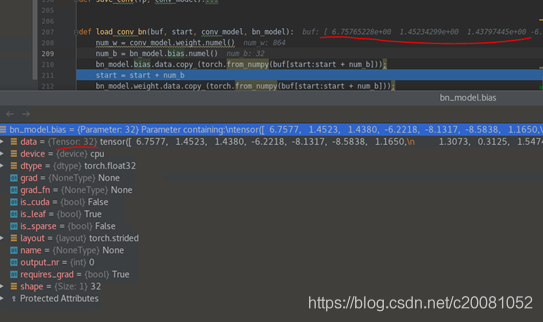

而如下几个block类型在训练过程中是不会生成权重值的,所以不用从yolov4.weights中取值;
elif block['type'] == 'maxpool':
pass
elif block['type'] == 'reorg':
pass
elif block['type'] == 'upsample':
pass
elif block['type'] == 'route':
pass
elif block['type'] == 'shortcut':
pass
elif block['type'] == 'region':
pass
elif block['type'] == 'yolo':
pass
elif block['type'] == 'avgpool':
pass
elif block['type'] == 'softmax':
pass
elif block['type'] == 'cost':
pass
完成cfg文件的解析,模型的创建与权重文件的加载之后,现在要做的就是执行检测操作了,主要调用了utils/utils.py中的do_detect()函数,在demo.py中就是这行代码:boxes = do_detect(m, sized, 0.5, 0.4, use_cuda)
def do_detect(model, img, conf_thresh, nms_thresh, use_cuda=1):
model.eval() #模型做推理
t0 = time.time()
if isinstance(img, Image.Image):
width = img.width
height = img.height
img = torch.ByteTensor(torch.ByteStorage.from_buffer(img.tobytes()))
img = img.view(height, width, 3).transpose(0, 1).transpose(0, 2).contiguous() # CxHxW
img = img.view(1, 3, height, width) # 对图像维度做变换,BxCxHxW
img = img.float().div(255.0) # [0-255] --> [0-1]
elif type(img) == np.ndarray and len(img.shape) == 3: # cv2 image
img = torch.from_numpy(img.transpose(2, 0, 1)).float().div(255.0).unsqueeze(0)
elif type(img) == np.ndarray and len(img.shape) == 4:
img = torch.from_numpy(img.transpose(0, 3, 1, 2)).float().div(255.0)
else:
print("unknow image type")
exit(-1)
if use_cuda:
img = img.cuda()
img = torch.autograd.Variable(img)
list_boxes = model(img) # 主要是调用了模型的forward操作,返回三个yolo层的输出
anchors = [12, 16, 19, 36, 40, 28, 36, 75, 76, 55, 72, 146, 142, 110, 192, 243, 459, 401]
num_anchors = 9 # 3个yolo层共9种锚点
anchor_masks = [[0, 1, 2], [3, 4, 5], [6, 7, 8]]
strides = [8, 16, 32] # 每个yolo层相对输入图像尺寸的减少倍数分别为8,16,32
anchor_step = len(anchors) // num_anchors
boxes = []
for i in range(3):
masked_anchors = []
for m in anchor_masks[i]:
masked_anchors += anchors[m * anchor_step:(m + 1) * anchor_step]
masked_anchors = [anchor / strides[i] for anchor in masked_anchors]
boxes.append(get_region_boxes1(list_boxes[i].data.numpy(), 0.6, 80, masked_anchors, len(anchor_masks[i])))
# boxes.append(get_region_boxes(list_boxes[i], 0.6, 80, masked_anchors, len(anchor_masks[i])))
if img.shape[0] > 1:
bboxs_for_imgs = [
boxes[0][index] + boxes[1][index] + boxes[2][index]
for index in range(img.shape[0])]
# 分别对每一张图像做nms
boxes = [nms(bboxs, nms_thresh) for bboxs in bboxs_for_imgs]
else:
boxes = boxes[0][0] + boxes[1][0] + boxes[2][0]
boxes = nms(boxes, nms_thresh)
return boxes # 返回nms后的boxes模型forward后输出结果存在list_boxes中,因为有3个yolo输出层,所以这个列表list_boxes中又分为3个子列表;
其中list_boxes[0]中存放的是第一个yolo层输出,其特征图大小对于原图缩放尺寸为8,即strides[0], 对于608x608图像来说,该层的featuremap尺寸为608/8=76;则该层的yolo输出数据维度为[batch, (classnum+4+1)*num_anchors, feature_h, feature_w] , 对于80类的coco来说,测试图像为1,每个yolo层每个特征图像点有3个锚点,该yolo层输出是[1,255,76,76];对应锚点大小为[1.5,2.0,2.375,4.5,5.0,3.5]; (这6个数分别是3个锚点的w和h,按照w1,h1,w2,h2,w3,h3排列);
同理第二个yolo层检测结果维度为[1,255,38,38],对应锚点大小为:[2.25,4.6875,4.75,3.4375,4.5,9.125],输出为 [1,255,38,38]
第三个yolo层检测维度为[1,255,19,19],对应锚点大小为:[4.4375,3.4375,6.0,7.59375,14.34375,12.53125],输出为 [1,255,19,19];
do_detect()函数中主要是调用了get_region_boxes1(output, conf_thresh, num_classes, anchors, num_anchors, only_objectness=1, validation=False) 这个函数对forward后的output做解析并做nms操作;
每个yolo层输出数据分析,对于第一个yolo层,输出维度为[1,85*3,76,76 ]; 会将其reshape为[85, 1*3*76*76],即有1*3*76*76个锚点在预测,每个锚点预测信息有80个类别的概率和4个位置信息和1个是否包含目标的置信度;下图是第一个yolo输出层的数据(实际绘制网格数量不正确,此处只是做说明用)
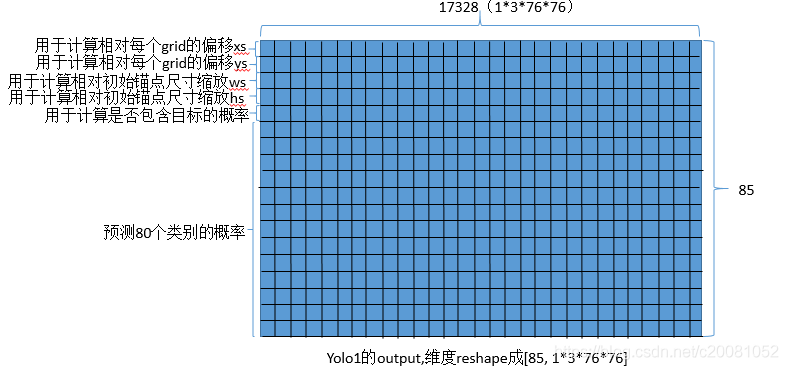
每个输出的对应代码实现为:

继续结合上面的图,分析对于某一个yolo层输出的数据是怎么排列的,其示意图如下:
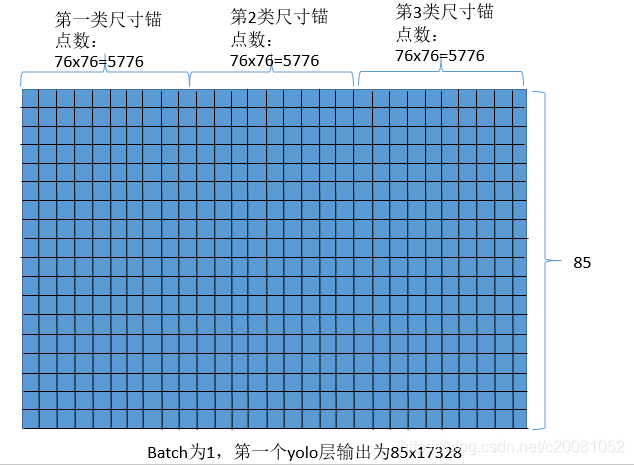
如果置信度满足阈值要求,则将预测的box保存到列表(其中id是所有output的索引,其值在0~batch*anchor_num*h*w范围内)
if conf > conf_thresh:
bcx = xs[ind]
bcy = ys[ind]
bw = ws[ind]
bh = hs[ind]
cls_max_conf = cls_max_confs[ind]
cls_max_id = cls_max_ids[ind]
box = [bcx / w, bcy / h, bw / w, bh / h, det_conf, cls_max_conf, cls_max_id]对于3个yolo层先是简单的对每个yolo层输出中是否含有目标做了过滤(含有目标的概率大于阈值);然后就是对三个过滤后的框合并到一个list中作NMS操作了;涉及的代码如下:
def nms(boxes, nms_thresh):
if len(boxes) == 0:
return boxes
det_confs = torch.zeros(len(boxes))
for i in range(len(boxes)):
det_confs[i] = 1 - boxes[i][4]
_, sortIds = torch.sort(det_confs) # sort是按照从小到大排序,那么sortlds中是按照有目标的概率由大到小排序
out_boxes = []
for i in range(len(boxes)):
box_i = boxes[sortIds[i]]
if box_i[4] > 0:
out_boxes.append(box_i) # 取出有目标的概率最大的box放入out_boxes中;
for j in range(i + 1, len(boxes)): #然后将剩下的box_j都和这个box_i进行IOU计算,若与box_i重叠率大于阈值,则将box_j的包含目标概率值置为0(即不选它)
box_j = boxes[sortIds[j]]
if bbox_iou(box_i, box_j, x1y1x2y2=False) > nms_thresh:
# print(box_i, box_j, bbox_iou(box_i, box_j, x1y1x2y2=False))
box_j[4] = 0
return out_boxes补充:
论文中提到的mish激活函数:
公式是这样的(其中x是输入)
![]()
对应的图是:

##Pytorch中的代码实现为:
class Mish(torch.nn.Module):
def __init__(self):
super().__init__()
def forward(self, x):
x = x * (torch.tanh(torch.nn.functional.softplus(x)))
return x
#--------------------------------------------------------------#
Tensorflow的代码实现为:
import tensorflow as tf
from tensorflow.keras.layers import Activation
from tensorflow.keras.utils import get_custom_objects
class Mish(Activation):
def __init__(self, activation, **kwargs):
super(Mish, self).__init__(activation, **kwargs)
self.__name__ = 'Mish'
def mish(inputs):
return inputs * tf.math.tanh(tf.math.softplus(inputs))
get_custom_objects().update({'Mish': Mish(mish)})
#使用方法
x = Activation('Mish')(x)文中提到的SPP结构大致是:
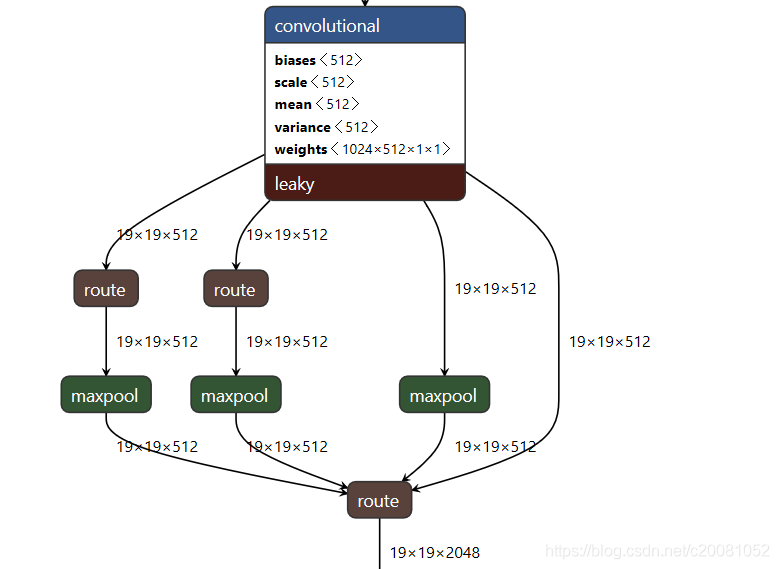
Pytorch指定运行的GPUID号的方法,https://www.cnblogs.com/jfdwd/p/11434332.html







评论(0)
您还未登录,请登录后发表或查看评论